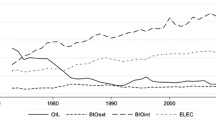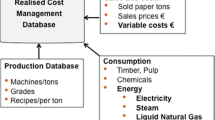Abstract
Despite the need for increased industrial energy efficiency, studies indicate that cost-effective energy efficiency measures are not always implemented, which is explained by the existence of barriers to energy efficiency. This paper investigates whether this holds for the Swedish pulp and paper industry, and if so, investigates the barriers inhibiting and the driving forces stressing cost-effective energy efficiency investments. By so, this case study covers about 2% of the EU-25 industrial end-use of energy. The overall results from a questionnaire show that there is an energy efficiency gap in the sector and that the largest barriers were technical risks such as risk of production disruptions, cost of production disruption/hassle/inconvenience, technology inappropriate at the mill, lack of time and other priorities, lack of access to capital, and slim organization. As regards the driving forces for energy efficiency, the highest ranked driving forces were cost reductions resulting from lower energy use, people with real ambition, long-term energy strategy, the threat of rising energy prices, the electricity certificate system, the PFE. The results show that many of the barriers and driving forces were not solely market-related, e.g., lack of time or other priorities, slim organization, other priorities for capital investments, lack of staff awareness, and long decision chains indicate that firm-specific barriers plays an important role. These barriers may not be overcome by market-related public policy instruments but is rather a consequence of how the energy issue is organized within the firms. The second and the third largest driving forces, people with real ambition and a long-term energy strategy further support this.


Similar content being viewed by others
Notes
For an overview of the debate regarding energy efficiency and its impact, please see Geller and Attali (2005).
A cost-effective energy conservation measure is defined as an investment which lowers the use of energy and which is considered cost-effective according to the Mill’s investment criteria.
Like Schleich and Gruber (2007), this paper investigates energy-efficient investments in general and does not focus on a single technology.
References
Andersson, E., Harvey, S., & Berntsson, T. (2006). Energy efficient upgrading of biofuel integrated with a pulp mill. Energy, 31(10–11), 1384–1394.
Anderson, S. T., & Newell, R. G. (2004). Information programs for technology adoption: The case of energy-efficiency audits. Resource and Energy Economics, 26(1), 27–50.
Bengtsson, C., Karlsson, M., Berntsson, T., & Soderstrom, M. (2001). Co-ordination of pinch technology and the MIND method. Applied Thermal Engineering, 22(2), 133–144.
Bertoldi, P., Starzer, O., & Sattler, M. (2003). Combining long term agreements with emissions trading: An overview of the current EU energy efficiency policies for the industrial sector and a proposal for a new industrial efficiency policy (Paper presented at the 2003 American Council for an Energy Efficient Economy (ACEEE) summer study on energy efficiency in industry).
Brown, M. A. (2001). Market failures and barriers as a basis for clean energy policies. Energy Policy, 29(14), 1197–1207.
Churchman, C. W. (1968). The systems approach. New York: Dell Publishing Co. Inc.
DeCanio, S. (1993). Barriers within firms to energy efficient investments. Energy Policy, 9(1), 906–914.
de Groot, H., Verhoef, E., & Nijkamp, P. (2001). Energy saving by firms: Decision-making, barriers and policies. Energy Economics, 23(6), 717–740.
del Rio Gonzàlez, P. (2005). Analysing the factors influencing clean technology adoption: A study of the Spanish pulp and paper industry. Business Strategy and the Environment, 14(1), 20–37.
EC (European Commission), (2006). Directive 2006/32/EC of the European Parliament and of the Council of 5 April 2006 on energy end-use efficiency and energy services and repealing Council Directive 93/76/ EEC, Brussels.
Eurostat. (2007). Final energy consumption, by sector. Retrieved October 25, 2007, from the Eurostat’s Web site: http://epp.eurostat.ec.europa.eu/portal/page?_pageid = 1996,39140985&_dad = portal&_schema = PORTAL&screen = detailref&language = en&product = sdi_cc&root = sdi_cc/sdi_cc/sdi_cc_ene/sdi_cc2200.
Farla, J. C. M., & Blok, K. (1995). Energy conservation investment behaviour of firms: analysis of investments in energy efficiency in the Netherlands in the 1980s. (Paper presented at the 1995 American Council for an Energy Efficient Economy (ACEEE) summer study on energy efficiency in industry).
Geller, H., & Attali, S. (2005). The experience with energy efficiency policies and programmes in IEA countries – Learning from the Critics. Retrieved October 8, 2007, from the IEA’s Web site: http://www.iea.org/textbase/papers/2005/efficiency_policies.pdf.
Hietaniemi, J., & Ahtila, P. (2007). Energy conservation agreements within Finnish pulp and paper industry – methods and results. Retrieved October 8, 2007, from the Motiva’s Web site: http://www.motiva.fi/attachment/f16d4d543f99d7a59f5 4560a69063a0e/dcda18330aa306eb83d12fd3b6e09cbd/PP2004-teksti.pdf.
Hirst, E., & Brown, M. A. (1990). Closing the efficiency gap: Barriers to the efficient use of energy. Resources, Conservation and Recycling, 3(4), 267–281.
Holmberg, J. M., & Gustavsson, L. (2007). Biomass use in chemical and mechanical pulping with biomass-based energy supply. Resources, Conservation and Recycling, 52, 331–350.
Howarth, R., & Andersson, B. (1993). Market barriers to energy efficiency. Energy Economics, 15(4), 262–272.
IPCC (2007). Contribution of Working Group III to the Fourth Assessment Report of the Intergovernmental Panel on Climate Change. Summary for Policymakers. Retrieved October 8, 2007 from http://www.ipcc.ch/SPM040507.pdf.
Jaffe, A., & Stavins, R. (1994). The energy-efficiency gap. What does it mean. Energy Policy, 22(10), 804–810.
Johansson, B., Modig, G., & Nilsson, L. J. (2007). Policy instruments and industrial responses – Experiences from Sweden. (Paper presented at the 2007 European Council for an Energy-Efficient Economy (ECEEE) summer study “Saving energy – just do it”, Panel 7, 1413–1421).
Klugman, S., Karlsson, M., & Moshfegh, B. (2007). A Scandinavian chemical wood pulp mill. Part 1. Energy audit aiming at efficiency measures. Applied Energy, 84(3), 326–339.
Laestadius, S. (1998). Technology level, knowledge formation, and industrial competence in paper manufacturing. In G. Eliason, C. Green, & C. R. McCann (Eds.) Microfoundation of economic growth: A Schumpeterian perspective. Ann Arbor, MI: The University of Michigan Press.
Masurel, E. (2007). Why SMEs invest in environmental measures: Sustainability evidence from small and medium-sized printing firms. Business Strategy and the Environment, 16, 190–201.
Möllersten, K., Yan, J., & Westermark, M. (2003). Potential and cost-effectiveness of CO2 reductions through energy measures in Swedish pulp and paper mills. Energy, 28(7), 691–710.
Nilsson, L., Larson, E., Gilbreath, K., & Gupta, A. (1996). Energy efficiency and the pulp and paper industry. Report number IE962. Washington, DC: American Council for an Energy-Efficient Economy.
Ostertag, K. (1999). Transaction costs of raising energy efficiency. (Paper presented at the 2007 IEA international Workshop on Technologies to Reduce Greenhouse gas Emissions: Engineering-Economic Analyses of Conserved Energy and Carbon).
Ottosson, C., & Peterson, K. (2007). First results from the Swedish LTA programme for energy efficiency in industry. (Paper presented at the 2007 European Council for an Energy-Efficient Economy (ECEEE) summer study “Saving energy – just do it”, Panel 7, 1517–1525).
Rohdin, P., & Thollander, P. (2006a). Barriers to and driving forces for energy efficiency in the non-energy intensive manufacturing industry in Sweden. Energy, 31(12), 1836–1844.
Rohdin, P., & Thollander, P. (2006b). Perspectives on energy efficiency, manufacturing simulation, energy audits and public policies (in Swedish: Synen på energieffektivisering, produktionssimulering, energianalyser och styrmedel – en studie av nio svenska gjuterier), Swecast, Jönköping.
Rohdin, P., Thollander, P., & Solding, P. (2007). Barriers to and drivers for energy efficiency in the Swedish foundry industry. Energy Policy, 35(1), 672–677.
SCB, (2006). SCB’s statistical database, statistikdatabas, Retrieved October 8, 2007, from the SCB’s Web site: www.scb.se.
Schleich, J., & Gruber, E. (2007). Beyond case studies: Barriers to energy efficiency in commerce and the services sector. Energy Economics 30(2), 449–464.
SEA (Swedish Energy Agency). (2007a). Energy in Sweden 2006, Facts and figures. Retrieved October 8, 2007, from the Swedish Energy Agency’s Web site: http://www.energimyndigheten.se/web/biblshop.nsf/FilAtkomst/ET2006_ 44.pdf/$FILE/ET2006_44.pdf?OpenElement.
SEA (Swedish Energy Agency). (2007b). Energy in Sweden 2006. Retrieved October 8, 2007, from the Swedish Energy Agency’s Web site: http://www.energimyndigheten.se/web/biblshop.nsf/FilAtkomst/ET2006_45.pdf/$FILE/ET 2006_45.pdf?OpenElement.
SEA (Swedish Energy Agency). (2007c). Two years with PFE. Retrieved October 8, 2007, from the Swedish Energy Agency’s Web site: http://www.energimyndigheten.se/web/biblshop.nsf/FilAtkomst/ET2007_16.pdf/$FILE/ET 2007_16.pdf?OpenElement.
SEA (Swedish Energy Agency). (2007d). The electricity certificate system, 2007. Retrieved October 8, 2007 from the Swedish Energy Agency’s Web site: http://www.energimyndigheten.se/web/biblshop_eng.nsf/FilAtkomst/ET2007 _27.pdf/$FILE/ET2007_27.pdf?OpenElement.
SEA (Swedish Energy Agency). (2007e). The European trading scheme’s impact upon industry – a decision making report. (in Swedish: Europeiska utsläppshandelssystemets påverkan på industrin – en underlagsrapport), ER2007:08, SEA, Stockholm.
SFI (Swedish Forest Industries), (2005). Energy use in the pulp and paper industry 2000 (In Swedish: Energiförbrukning i massa- och pappersindustrin 2000). Retrieved October 8, 2007, from the Swedish Forest Industries’ Web site: http://www.skogsindustrierna.se/LitiumDokument20/Get Document.asp?archive = 3&directory = 27&document = 257.
SFI (Swedish Forest Industries), (2007). Retrieved October 8, 2007, from the Swedish Forest Industries’s Web site: http://www.skogsindustrierna.se/LitiumInformation/site/page.asp?Page = 10&IncPage = 626&IncPage2 = 232&Destination = 227&destination2 = 226&ohKatID = 5&ohID = 13&lang = sv.
Sorrell, S., Schleich, J., Scott, S., O’Malley, E., Trace, F., Boede, E., et al. (2000). Reducing Barriers to Energy Efficiency in Public and Private Organizations. Retrieved October 8, 2007 from the SPRU’s (Science and Technology Policy Research) Web site: http://www.sussex.ac.uk/Units/spru /publications/reports/ barriers/final.html.
Stern, P. C., & Aronsson, E. (Eds.) (1984). Energy use: the human dimension. New York: W.H. Freeman and Company
STFI (2003). Ecocyclic pulp mill – “KAM” – Final report 1996–2002, KAM Report A100. Stockholm: Swedish Pulp and Research Institute.
Thollander, P., Danestig, M., & Rohdin, P. (2007). Energy policies for increased industrial energy efficiency: Evaluation of a local energy programme for manufacturing SMEs. Energy Policy, 35(11), 5774–5783
Velthuijsen, J. W. (1995). Determinants of investments in energy conservation, Dissertation, Rijksuniversiteit.
Weber, L. (1997). Some reflections on barriers to the efficient use of energy. Energy Policy, 25(10), 833–835.
Wising, U., Berntsson, T., & Stuart, P. (2005). The potential for energy savings when reducing the water consumption in a Kraft Pulp Mill. Applied Thermal Engineering, 25(77), 1057–1066.
Yin, R. K. (1994). Case Study Research: Design and Method. Applied Social Research Methods, vol. 5. Sage, London.
Acknowledgments
The work has been carried out under the auspices of the Energy System Programme, which is financed by the Swedish Foundation for Strategic Research and the Swedish Energy Agency. We kindly thank the respondents at the studied mills for giving freely their time to answer the questionnaire. We would also like to thank Jörgen Persson, Johanna Jönsson, and Thore Berntsson of Chalmers University of Technology and Patrik Rohdin, Mats Söderström, Mats Bladh, and Jonas Anshelm of Linköping University for valuable comments on earlier drafts of this paper. The usual disclaimer applies.
Author information
Authors and Affiliations
Corresponding author
Rights and permissions
About this article
Cite this article
Thollander, P., Ottosson, M. An energy efficient Swedish pulp and paper industry – exploring barriers to and driving forces for cost-effective energy efficiency investments. Energy Efficiency 1, 21–34 (2008). https://doi.org/10.1007/s12053-007-9001-7
Received:
Accepted:
Published:
Issue Date:
DOI: https://doi.org/10.1007/s12053-007-9001-7




